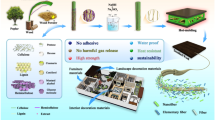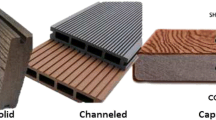Abstract
Thermal modification is widely applied to improve moisture dynamics of wood, however often decreasing the mechanical strength. It is therefore required to enhance the mechanical strength of thermally modified timber (TMT), for example by impregnation with adhesives. Specimens, cut from Douglas-fir, were thermally modified (TM) either after phenol formaldehyde (PF) resin impregnation (IM-TM) or before (TM-IM). The microstructural and chemical properties were investigated with SEM and FTIR. Compressive stress, as one of the important mechanical properties, was measured using a universal testing machine, while strain distribution was recorded with digital image correlation (DIC). The results show that the compressive stress of TM specimens can be enhanced significantly by PF resin impregnation. Compressive stress differences between IM-TM and TM-IM specimens are small despite of the larger amount of resin in TM-IM specimens. Thermal modification decomposes part of the PF resin in the cell lumens and promotes chemical reaction between the PF resin and wood. PF resin improves the stiffness and ductility of the wood cell wall, resulting in smaller strain and homogenous distribution thereof. These factors lead to high compressive stress of IM-TM and TM-IM specimens. Although PF resin impregnation contributes to narrowing strain accumulation in earlywood of TM specimens, control specimens have the smallest strain ratio between earlywood and latewood. The findings of this study are helpful for optimizing the cost effective thermal-impregnation technology of producing TMT with improved compressive stress.








Similar content being viewed by others
References
Acosta AP, Delucis R, Amico SC et al (2021) Fast-growing pine wood modified by a two-step treatment based on heating and in situ polymerization of polystyrene. Constr Build Mater 302:124422
Awoyemi L, Westermark U (2005) Effects of borate impregnation on the response of wood strength to heat treatment. Wood Sci Technol 39:484–491
Baar J, Brabec M, Slávik R et al (2021) Effect of hemp oil impregnation and thermal modification on European beech wood properties. Eur J Wood Prod 79:161–175
Bekhta P (2020) Effect of heat treatment on some physical and mechanical properties of birch plywood. Eur J Wood Prod 78:683–691
Bernabei M, Salvatici MC (2016) In situ ESEM observations of spruce wood (Picea abies Karst.) during heat treatment. Wood Sci Technol 50:715–726
Boonstra MJ, Van Acker J, Tjeerdsma BF et al (2007) Strength properties of thermally modified softwoods and its relation to polymeric structural wood constituents. Ann for Sci 64:679–690
Boonstra MJ, Tjeerdsma B (2006) Chemical analysis of heat treated softwoods. Eur J Wood Prod 64:204–211
Cabezas-Romero JL, Salvo-Sepulveda L, Contreras-Moraga H et al (2021) Microstructure of thermally modified Radiata Pine wood. BioResources 16:1523–1533
Cademartori PHG, dos Santos PSB, Serrano L et al (2013) Effect of thermal treatment on physicochemical properties of Gympie messmate wood. Ind Crops Prod 45:360–366
de Abreu NR, Lima JT, Takarada LM et al (2021) Effect of thermal treatment on fiber morphology in wood pyrolysis. Wood Sci Technol 55:95–108
Gunduz G, Korkut S et al (2009) The density, compression strength and surface hardness of treated Hornbeam (Carpinus betulus L.) wood. Maderas: Cienc y Tecnol 11:61–70
He G, Riedl B (2004) Curing kinetics of phenol formaldehyde resin and wood-resin interactions in the presence of wood substrates. Wood Sci Technol 38:69–81
Lee SH, Ashaari Z, Lum WC et al (2018) Thermal treatment of wood using vegetable oils: a review. Constr Build Mater 181:408–419
Li WZ, Zhang Z, Wang XZ et al (2021) Understanding the effect of growth ring orientation on the compressive strength perpendicular to the grain of thermally treated wood. Wood Sci Technol 55:1439–1456
Salman S, Petrissans A, Thevenon MF et al (2016) Decay and termite resistance of pine blocks impregnated with different additives and subjected to heat treatment. Eur J Wood Prod 74:37–42
Shams MI, Yano H, Endou K (2004) Compressive deformation of wood impregnated with low molecular weight phenol formaldehyde (PF) resin I: effects of pressing pressure and pressure holding. J Wood Sci 50:337–342
Singh T, Page D, Simpson I (2019) Manufactured structural timber building materials and their durability. Constr Build Mater 217:84–92
Taghiyari HR, Bayani S, Militz H et al (2020) Heat treatment of pine wood: possible effect of impregnation with silver nanosuspension. Forests 11:466
Van Blokland J, Olsson A, Oscarsson J et al (2020) Crack formation, strain distribution and fracture surfaces around knots in thermally modified timber loaded in static bending. Wood Sci Technol 54:1001–1028
Wang W, Chen C, Cao JZ et al (2018a) Improved properties of thermally modified wood (TMW) by combined treatment with disodium octoborate tetrahydrate (DOT) and wax emulsion (WE). Holzforschung 72:243–250
Wang X, Chen X, Xie X et al (2018b) Effects of thermal modification on the physical, chemical and micromechanical properties of Masson pine wood (Pinus mossoniano Lamb.). Holzforschung 72:1063–1070
Wang XZ, Chen XZ, Xie XQ et al (2019a) Effect of phenol formaldehyde resin penetration on the quasi-static and dynamic mechanics of wood cell walls using nanoindentation. Nanomaterials (basel, Switzerland) 9(10):1409
Wang XZ, Chen XZ, Xie XQ et al (2019b) Multi-scale evaluation of the effect of phenol formaldehyde resin impregnation on the dimensional stability and mechanical properties of pinus massoniana lamb. Forests 10:646
Wang X, Cheng D, Huang X et al (2020a) Effect of high-temperature saturated steam treatment on the physical, chemical, and mechanical properties of moso bamboo. J Wood Sci 66:52–61
Wang XZ, Deng YH, Li YJ et al (2016) In situ identification of the molecular-scale interactions of phenol-formaldehyde resin and wood cell walls using infrared nanospectroscopy. RSC Adv 6:76318–76324
Wang JF, Yao Y, Huang YQ et al (2022) Effects of the combination of compression and impregnation with phenolic resin on the dimensional stability in the multiscale wood structure of Chinese fir. Constr Build Mater 327:126960
Wang Z, Zou W, Sun D et al (2020b) Fabrication and performance of in-depth hydrophobic wood modified by a silica/wax complex emulsion combined with thermal treatment. Wood Sci Technol 54:123–129
Widmann R, Fernandez-Cabo JL, Steiger R (2012) Mechanical properteis of thermally modified beech timber for structural purposes. Eur J Wood Prod 70:775–784
Wimmer R, Kläusler RO, Niemz P (2013) Water sorption mechanisms of commercial wood adhesive films. Wood Sci Technol 47:763–775
Wolcott MP, Kamke FA, Dillard DA (1994) Wood deformation pertaining to manufacture of wood-based composites. Wood Fiber Sci 26(4):496–511
Wolcott MP, Kasal B, Kamke FA (1989) Testing small wood specimens in transverse compression. Wood Fiber Sci 21(3):320–329
Wouts J, Haugou G, Oudjene M et al (2016) Strain rate effects on the compressive response of wood and energy absorption capabilities - part a: experimental investigations. Compos Struct 149:315–328
Wu MH, Jin JW, Cai JB et al (2020) Effects of impregnation combined heat treatment on the pyrolysis behavior of poplar wood. PLoS ONE 15:0229907
Zhan T, Jiang J, Lu J et al (2019) Temperature-humidity-time equivalence and relaxation in dynamic viscoelastic response of Chinese fir wood. Constr Build Mater 227:116637
Acknowledgements
This study was financially supported by The National High Technology Research and Development Program of China (2021YFD2200602) and The Postgraduate Research and Practice Innovation Program of Jiangsu Province (SJCX21_0333). We declare that we have no financial and personal relationships with other people or organizations that can inappropriately influence our work, there is no commercial or associative interest that represents a conflict of interest in connection with the work submitted.
Author information
Authors and Affiliations
Corresponding author
Additional information
Publisher's Note
Springer Nature remains neutral with regard to jurisdictional claims in published maps and institutional affiliations.
Rights and permissions
About this article
Cite this article
Li, W., Zhang, Z., Yang, K. et al. Understanding the effect of combined thermal treatment and phenol–formaldehyde resin impregnation on the compressive stress of wood. Wood Sci Technol 56, 1071–1086 (2022). https://doi.org/10.1007/s00226-022-01400-2
Received:
Accepted:
Published:
Issue Date:
DOI: https://doi.org/10.1007/s00226-022-01400-2




